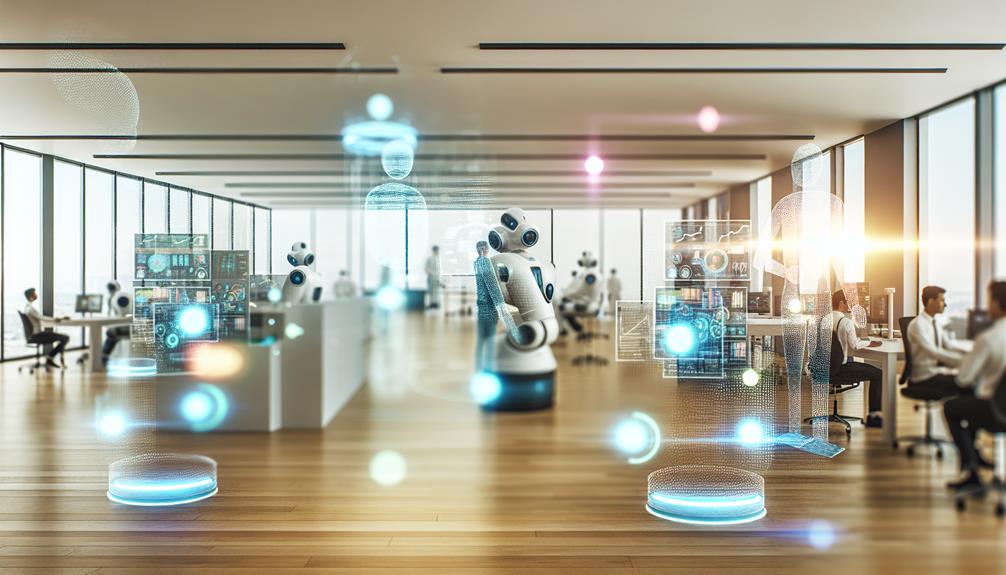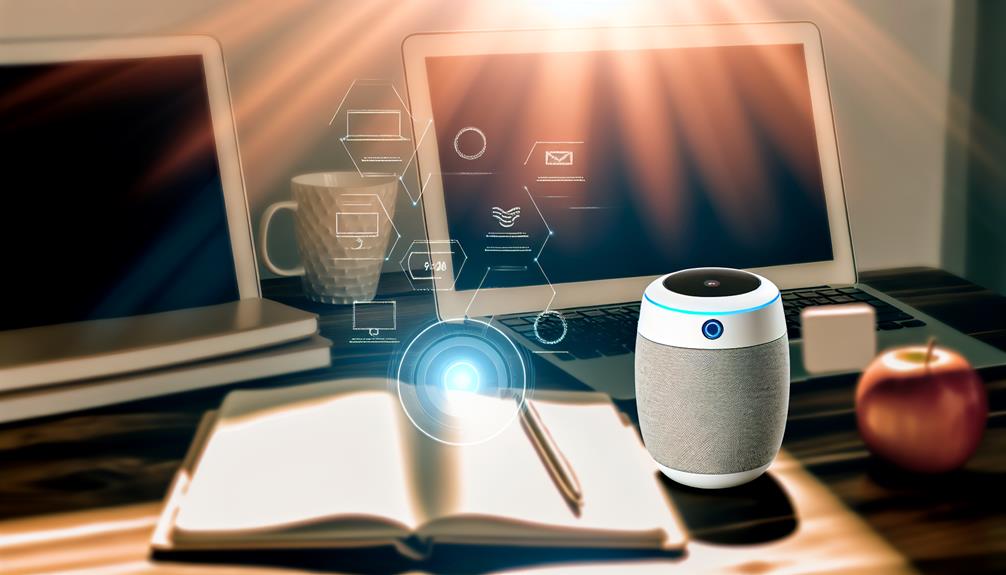Genuine Insights on Emerging Productivity Automation Trends
The landscape of productivity automation is undergoing significant transformation, marked by the rise of AI-powered tools and enhanced workflow automation. Organizations are increasingly integrating smart gadgets to facilitate real-time collaboration, while personalization in productivity applications is redefining task management. As businesses invest in training and technology adoption, they stand to not only reduce costs but also elevate employee engagement. However, the implications of these trends extend beyond mere efficiency—what might be the long-term impact on workplace culture and employee dynamics?
Key takeaways
- AI-powered tools are transforming productivity by automating repetitive tasks, improving process efficiency, and reducing operational costs.
- Integration of smart gadgets enhances workplace connectivity, streamlining operations and fostering real-time collaboration among team members.
- Enhanced workflow automation minimizes manual errors, optimizes task management, and provides data-driven insights for better decision-making.
- Personalization in productivity apps tailors features to user needs, improving user engagement and enhancing team dynamics through targeted feedback.
- Real-time collaboration technologies enable seamless interaction among remote teams, ensuring effective communication and maintaining synergy through cloud-based solutions.
Rise of AI-Powered Tools
The rise of AI-powered tools has fundamentally transformed the landscape of productivity automation, enabling organizations to streamline processes and enhance efficiency. These tools offer remarkable scalability, allowing businesses to customize solutions that grow alongside their needs.
However, the implementation of AI solutions raises critical questions about AI ethics, particularly concerning transparency and accountability in automated decision-making.
User adoption plays a pivotal role in the success of these technologies. Organizations must invest in training and change management to guarantee that employees embrace AI tools, fostering a culture of collaboration and innovation.
Additionally, data security remains a paramount concern; as AI systems increasingly rely on vast amounts of sensitive information, robust measures are necessary to protect against breaches and misuse.
Cost-effectiveness is another significant advantage of AI-powered tools, as they often reduce operational costs by automating repetitive tasks and enhancing productivity.
The industry impact of these technologies is profound, reshaping workflows and driving competitive advantages. As organizations navigate this evolving landscape, a balanced approach that prioritizes ethical considerations and user engagement will be essential for maximizing the potential of AI in productivity automation.
Integration of Smart Gadgets
Embracing the integration of smart gadgets into workplace environments is reshaping productivity automation by enhancing connectivity and streamlining operations.
The convergence of smart home integration and wearable technology is fostering a seamless exchange of data, enabling employees to engage with their work in innovative ways.
Smart gadgets, from voice-activated assistants to interconnected devices, facilitate real-time communication and collaboration among team members, irrespective of their physical location.
This integration not only simplifies routine tasks but also empowers employees to focus on higher-value activities, ultimately driving workplace efficiency.
Wearable technology, such as smartwatches and fitness trackers, enhances individual productivity by providing instant access to notifications and health metrics.
These devices encourage a culture of wellness, as employees can monitor their well-being while managing their workload.
Moreover, the data generated from these smart gadgets can be analyzed to identify patterns and optimize workflow, fostering a more responsive and adaptive work environment.
As organizations cultivate this interconnected ecosystem, they create a sense of belonging and community, where employees feel supported by technology that enhances their daily experiences.
Consequently, the integration of smart gadgets is not merely a trend; it is a transformational approach to productivity automation.
Enhanced Workflow Automation
As organizations increasingly adopt smart gadgets to enhance connectivity and streamline operations, the focus is shifting toward enhanced workflow automation. This evolution not only supports task management but greatly elevates process optimization, allowing teams to function with greater efficiency and agility.
Enhanced workflow automation integrates various tools and technologies that automate repetitive tasks, reducing manual intervention and minimizing errors. By leveraging intelligent systems, organizations can guarantee that tasks are assigned, tracked, and completed in a timely manner, fostering a culture of accountability and collaboration.
Moreover, the real-time insights provided by automated workflows empower decision-makers to identify bottlenecks and streamline processes. This data-driven approach enables organizations to refine their operations continuously, leading to improved productivity and resource allocation.
The integration of automation into workflows cultivates a sense of belonging among team members as they engage in value-added activities rather than mundane tasks.
Personalization in Productivity Apps
Personalization in productivity apps is revolutionizing how individuals and teams approach task management and collaboration. By leveraging user-centric design principles, these applications are increasingly tailored to meet the specific needs and preferences of their users. This shift towards personalization not only enhances user engagement but also fosters a sense of belonging within diverse teams, as individuals can customize their workflows to align with personal and collective goals.
User feedback plays a critical role in this evolution, guiding developers to refine features and interfaces that truly resonate with users. By actively soliciting insights from their audience, productivity apps can adapt to changing work habits and preferences, ensuring that the tools remain relevant and effective.
Additionally, this iterative process of incorporating user feedback helps build trust and loyalty among users, reinforcing their commitment to the app.
As we embrace a more personalized approach to productivity, it becomes clear that the future of task management and collaboration lies in creating environments where individuals feel understood and valued. In doing so, productivity apps not only enhance individual performance but also strengthen team dynamics, ultimately driving greater organizational success.
Real-Time Collaboration Technologies
Real-time collaboration technologies have transformed the landscape of teamwork by enabling seamless interaction among distributed teams. As organizations increasingly adopt cloud-based solutions, the synergy between team members is enhanced, fostering a sense of belonging and inclusivity. These technologies bridge geographical gaps, allowing teams to collaborate effectively regardless of location.
| Technology | Key Features | Benefits |
|---|---|---|
| Video Conferencing | High-definition video, screen sharing | Improved communication, better engagement |
| Collaborative Tools | Document editing, task management | Enhanced productivity, real-time updates |
| Messaging Platforms | Instant messaging, file sharing | Quick feedback, streamlined communication |
The rise of real-time collaboration tools not only bolsters efficiency but also nurtures an environment where team members feel connected and valued. By leveraging these cloud-based solutions, organizations can harness the collective strengths of their teams, driving innovation and creativity. As businesses navigate the complexities of remote work, embracing real-time collaboration technologies is essential to maintaining team synergy and fostering a cohesive workplace culture. In this digital age, the ability to collaborate in real-time is no longer a luxury but a necessity for thriving in a competitive landscape.
Frequently Asked Questions
How Can Small Businesses Leverage Productivity Automation Effectively?
In an era where productivity automation reigns supreme, small businesses can embrace automation tools for workflow optimization, ensuring cost efficiency through strategic software integration, enhanced task prioritization, and thorough employee training to foster a culture of innovation.
What Industries Benefit the Most From Automation Trends?
Industries such as manufacturing, healthcare, retail, logistics, finance, education, and marketing greatly benefit from automation trends, enhancing efficiency, optimizing operations, innovating strategies, and improving customer service, ultimately fostering a more connected and productive environment.
Are There Risks Associated With Implementing Automation Tools?
Implementing automation tools carries risks, including potential automation pitfalls and workforce displacement. Organizations must strategically address these challenges to foster a balanced approach that enhances productivity while ensuring workforce stability and engagement within their teams.
How Can Employees Adapt to Increased Automation in the Workplace?
"Adapt or perish," emphasizes the need for employees to embrace skill development amidst job evolution. By actively engaging in continuous learning, individuals can enhance their adaptability, ensuring their relevance in an increasingly automated workplace landscape.
What Future Trends Should We Anticipate in Productivity Automation?
Future trends in productivity automation will likely include adaptive systems leveraging artificial intelligence and machine learning. These technologies will enhance collaboration and streamline workflows, fostering a sense of belonging among employees in increasingly automated environments.



